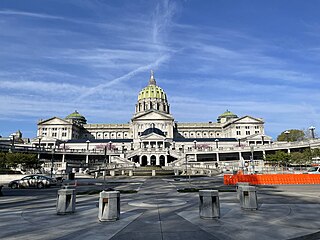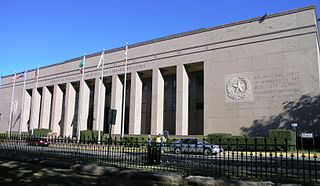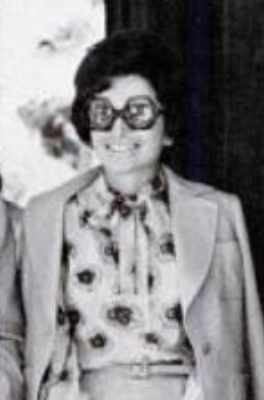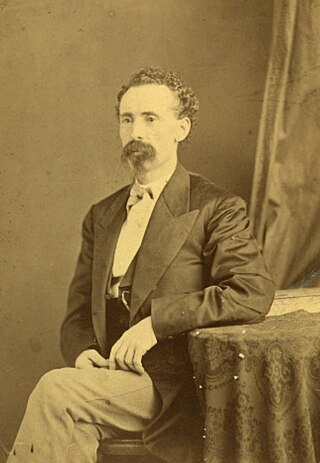
John William Bricker was an American politician and attorney who served as a United States senator and the 54th governor of Ohio. He was also the Republican nominee for Vice President in 1944.

The Texas State Capitol is the capitol and seat of government of the American state of Texas. Located in downtown Austin, Texas, the structure houses the offices and chambers of the Texas Legislature and of the Governor of Texas. Designed in 1881 by architect Elijah E. Myers, it was constructed from 1882 to 1888 under the direction of civil engineer Reuben Lindsay Walker. A $75 million underground extension was completed in 1993. The building was added to the National Register of Historic Places in 1970 and recognized as a National Historic Landmark in 1986.

The Architect of the Capitol (AOC) is the federal agency responsible for the maintenance, operation, development, and preservation of the United States Capitol Complex. It is an agency of the legislative branch of the federal government and is accountable to the United States Congress and the Supreme Court. Both the agency and the head of the agency are called "Architect of the Capitol". The head of the agency is appointed to a 10-year term by the President of the United States, confirmed by the United States Senate, and is accountable to the President.

The Minnesota State Capitol is the seat of government for the U.S. state of Minnesota, in its capital city of Saint Paul. It houses the Minnesota Senate, Minnesota House of Representatives, the office of the Attorney General and the office of the Governor. The building also includes a chamber for the Minnesota Supreme Court, although court activities usually take place in the neighboring Minnesota Judicial Center.

The California State Capitol is the seat of the California state government, located in Sacramento, the state capital of California. The building houses the chambers of the California State Legislature, made up of the Assembly and the Senate, along with the office of the governor of California. The Neoclassical structure, designed by Reuben S. Clark, was completed between 1861 and 1874. Located at the west end of Capitol Park and the east end of the Capitol Mall, the building was added to the National Register of Historic Places in 1973. The California State Capitol Museum is housed on the grounds of the capitol.

The Texas Historical Commission is an agency dedicated to historic preservation within the U.S. state of Texas. It administers the National Register of Historic Places for sites in Texas.

The Pennsylvania State Capitol is the seat of government for the U.S. state of Pennsylvania located in downtown Harrisburg which was designed by architect Joseph Miller Huston in 1902 and completed in 1906 in a Beaux-Arts style with decorative Renaissance themes throughout. The capitol houses the legislative chambers for the Pennsylvania General Assembly, made up of the House of Representatives and the Senate, and the Harrisburg chambers for the Supreme and Superior Courts of Pennsylvania, as well as the offices of the Governor and the Lieutenant Governor. It is also the main building of the Pennsylvania State Capitol Complex.

The Bullock Texas State History Museum is a history museum in Austin, Texas. The museum, located a few blocks north of the Texas State Capitol at 1800 North Congress Avenue in Austin, Texas, is dedicated to interpreting the continually unfolding "Story of Texas" to the broadest possible audience through meaningful educational experiences. The museum is operated by the Texas State Preservation Board, which also operates the Texas State Capitol, the Texas Capitol Visitors Center, the Texas Governor's Mansion, and the Texas State Cemetery.

The Texas State Library and Archives Commission (TSLAC) refers to the state government agency in the state of Texas that supports the reading, learning, and historical preservation needs of Texas and its people. The agency is charged with preserving the archival record of Texas, supporting research, and making primary resources available to the public; assisting public, academic, and school libraries across the state in meeting the needs of their communities and students; helping public agencies maintain their public records; and supporting the reading needs of thousands of Texans with disabilities preventing them from reading a standard book.
The architecture of the U.S. state of Texas comes from a wide variety of sources. Many of the state's buildings reflect Texas' Spanish and Mexican roots; in addition, there is considerable influence from mostly the American South as well as the Southwest. Rapid economic growth since the mid twentieth century has led to a wide variety of contemporary architectural buildings.

Gethsemane Lutheran Church is a historic Lutheran church in downtown Austin, Texas. Designated as a Recorded Texas Historic Landmark and listed on the National Register of Historic Places, the building currently holds offices of the Texas Historical Commission.

Rita Crocker Clements was an American Republican Party organizer, an activist in historic preservation, and a First Lady of the U.S. state of Texas.

Henry Arthur McArdle was an American painter of French and Irish ancestry. He was born in Belfast, Ireland on June 9, 1836, and immigrated as a teenager to the U.S. state of Maryland, where he studied at the Maryland Institute College of Art. During the American Civil War he was a cartographer in the service of Robert E. Lee. After the war he took a job at Baylor University and Baylor Female College and moved to Independence, Texas, where he was also known as Harry McArdle, with his new wife Jennie Smith.

The Confederate Soldiers Monument, also known as the Confederate Dead Monument, is a Confederate memorial installed outside the Texas State Capitol in Austin, Texas. It was erected in 1903. Its sculpture was designed by Pompeo Coppini, and its base was designed by Frank Teich. The sculpture was cast by Roman Bronze Works.

The Westgate Tower is a mixed-use high-rise building in downtown Austin, Texas. The twenty-six-story 261-foot (80 m) tower block was designed in 1962 and completed in 1966; its name reflects its location across the street from the west gate of the Texas State Capitol. Designed by architect Edward Durell Stone, the tower was added to the National Register of Historic Places in 2010 and designated a Recorded Texas Historic Landmark in 2012.

The Capitol View Corridors are a series of legal restrictions on construction in Austin, Texas, aimed at preserving protected views of the Texas State Capitol from various points around the city. First established by the Texas Legislature in 1983 and recodified in 2001, the corridors are meant to protect the capitol dome from obstruction by high-rise buildings. While supported by cultural and historical preservation organizations, the corridors have also been criticized for limiting the potential for the development of new tall structures in downtown Austin.
The Texas Confederate Museum was a museum in Austin, Texas, in the United States. The United Daughters of the Confederacy opened it in 1903 in a room on the ground floor of the Texas Capitol and closed it in 1988. From 1919 to 1988, it was housed on the ground floor of the Old Land Office Building, while the second floor housed a separate museum for the collections of the Daughters of the Republic of Texas. These museums occupied the structure even longer than the Texas Land Office did. In 1990, the Old Land Office Building reopened after closing for renovations as the Capitol Visitors Center and the museum closed. The paper portion of its collection was donated to the Nita Stewart Haley Memorial Library in Midland, Texas, the artifacts to the Texas Civil War Museum near Fort Worth.

The Ten Commandments Monument is installed on the Texas State Capitol grounds in Austin, Texas, United States. The Texas Sunset Red Granite artwork was designed by an unknown artist and erected by the Fraternal Order of Eagles of Texas in 1961. It was the subject of litigation in the Supreme Court case Van Orden v. Perry (2005).

The Battle of San Jacinto refers to at least two paintings by Henry Arthur McArdle, depicting the Battle of San Jacinto. One version, measuring approximately 8 feet (2.4 m) by 14 feet (4.3 m), is installed in the Texas Senate chamber of the Texas State Capitol in Austin, Texas. A smaller oil painting, measuring 5 feet (1.5 m) by 7 feet (2.1 m), was discovered in late 2009; this version is not a copy or study for the monumental painting in the Capitol.

















